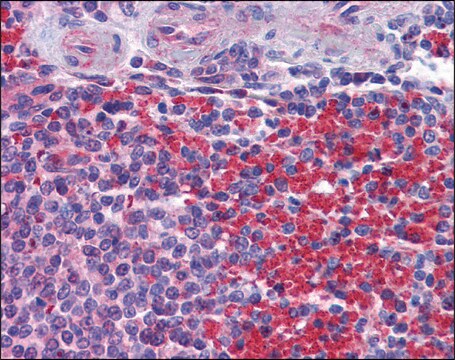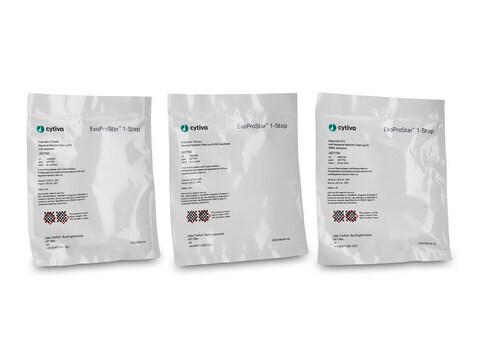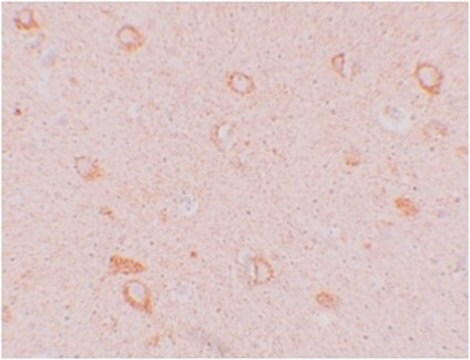推薦產品
生物源
mouse
共軛
unconjugated
抗體表格
purified immunoglobulin
抗體產品種類
primary antibodies
無性繁殖
7-1H, monoclonal
形狀
buffered aqueous solution
分子量
antigen ~130 kDa
物種活性
mouse, human
濃度
~2 mg/mL
技術
immunocytochemistry: suitable
western blot: 2-4 μg/mL using total cell extract of Raji cells
同型
IgG1
UniProt登錄號
運輸包裝
dry ice
儲存溫度
−20°C
目標翻譯後修改
unmodified
基因資訊
human ... CIITA(4261)
mouse ... Ciita(12265)
一般說明
Class II transactivator protein (CIITA) protein contains an acidic region in its N-terminal with transactivation activity, that binds to proteins in the basal transcription machinery and to cAMP response element-binding protein (CREB)-binding protein (CBP). The protein contains motifs for nuclear translocation, GTP binding motif and C-terminal leucine-rich repeats. CIITA is expressed constitutively in B lymphocytes and in immature dendritic cells, while in other cells its expression is induced by IFN-γ .
Monoclonal Anti-CIITA (mouse IgG1 isotype) is derived from the hybridoma 7-1H produced by the fusion of mouse myeloma cells (Sp20 cells) and splenocytes from BALB/c mice immunized with purified N-terminal recombinant CIITA, amino acids 1-350. CIITA is expressed constitutively in B lymphocytes and in immature dendritic cells, while in other cells its expression is induced by IFN-γ.
Monoclonal Anti-CIITA recognizes human1 and mouse † CIITA.
Monoclonal Anti-CIITA recognizes human1 and mouse † CIITA.
應用
The antibody may be used in immunoblotting (∼130 kDa) and immunocytochemistry.
生化/生理作用
Class II transactivator protein (CIITA) interacts with specific transcription factors and creates the appropriate transcriptional scaffold required for HLA-D gene expression.
外觀
0.01M 磷酸缓冲盐溶液,pH 7.4,含 15mM 叠氮化钠。
免責聲明
Unless otherwise stated in our catalog or other company documentation accompanying the product(s), our products are intended for research use only and are not to be used for any other purpose, which includes but is not limited to, unauthorized commercial uses, in vitro diagnostic uses, ex vivo or in vivo therapeutic uses or any type of consumption or application to humans or animals.
未找到適合的產品?
試用我們的產品選擇工具.
儲存類別代碼
10 - Combustible liquids
水污染物質分類(WGK)
WGK 3
閃點(°F)
Not applicable
閃點(°C)
Not applicable
個人防護裝備
Eyeshields, Gloves, multi-purpose combination respirator cartridge (US)
分析證明 (COA)
輸入產品批次/批號來搜索 分析證明 (COA)。在產品’s標籤上找到批次和批號,寫有 ‘Lot’或‘Batch’.。
Giovanna Barbieri et al.
International immunology, 14(8), 839-848 (2002-07-31)
The class II transactivator (CIITA) controls both the constitutive and IFN-gamma inducible expression of HLA-D genes. In addition, through the squelching of another transactivator CREB-binding protein, CIITA was more recently shown to have a wider cellular function, including cell cycle
H Zhou et al.
Journal of immunology (Baltimore, Md. : 1950), 158(10), 4741-4749 (1997-05-15)
The MHC class II transactivator gene (CIITA) coordinately controls the expression of the three major human class II genes, HLA-DR, HLA-DQ, and HLA-DP. Indeed, patients with one form of MHC class II immunodeficiency disease, due to defective CIITA genes, lack
Isoforms of the class II transactivator protein
Barbieri G, et al.
International Immunology, 14(8), 839-848 (2002)
W Wiszniewski et al.
Journal of immunology (Baltimore, Md. : 1950), 167(3), 1787-1794 (2001-07-24)
The expression of MHC class II molecules is essential for all Ag-dependent immune functions and is regulated at the transcriptional level. Four trans-acting proteins control the coordinate expression of MHC class II molecules: class II trans-activator (CIITA), regulatory factor binding
Rodrigo Naves et al.
International immunology, 14(5), 481-491 (2002-04-30)
MHC class II expression defects have been evidenced in several human tumor cell lines originating from lung cancers or retinoblastoma. Accordingly, the mouse adenocarcinoma and fibrosarcoma cell lines, RAG and L(tk-), do not express I-A and I-E molecules even when
我們的科學家團隊在所有研究領域都有豐富的經驗,包括生命科學、材料科學、化學合成、色譜、分析等.
聯絡技術服務







